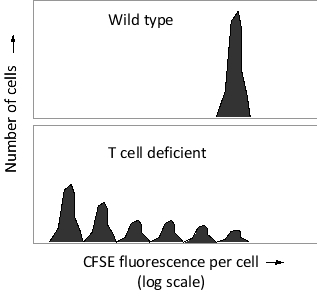Short Answer
CFSE (carboxyfluorescein succinimidyl ester) is a cell-tracing molecule that, once inside a cell, is modified to yield a highly fluorescent molecule that is retained within the cell. Due to its stability, it can be used to trace cells and follow their divisions: each division dilutes the fluorescent dye twofold. You label T cells from a healthy mouse with CFSE and inject them into either a wild-type strain of mouse or a strain with T cell deficiency, both of which are immunologically compatible with the donor mouse. You later collect and analyze peripheral T cells from the recipient mice and draw the following histograms according to the fluorescent intensity per cell. Based on these results, do you think the total number of T cells in the mouse body is (1) controlled by intracellular programs (as in the thymus, for example) or is (2) regulated as a whole (as in the spleen)? Write down 1 or 2 as your answer.

Correct Answer:

Verified
The injected T cells have divided (the ...View Answer
Unlock this answer now
Get Access to more Verified Answers free of charge
Correct Answer:
Verified
View Answer
Unlock this answer now
Get Access to more Verified Answers free of charge
Q51: The following graph qualitatively represents the gradients
Q52: In a developing Drosophila melanogaster embryo, a
Q53: An axonal growth cone has reached a
Q54: Indicate whether each of the following conditions
Q55: Assuming that the only function of Short
Q56: Consider Agrin signaling in the formation of
Q57: In the following graph, which line (1
Q58: A cross section of a developing spinal
Q59: TSH is a pituitary hormone that stimulates
Q61: Indicate whether each of the following descriptions